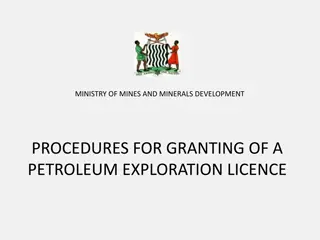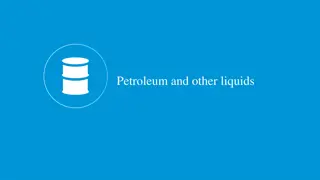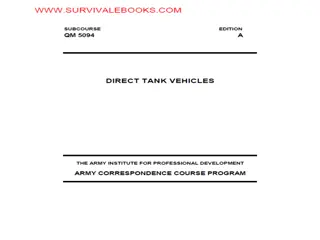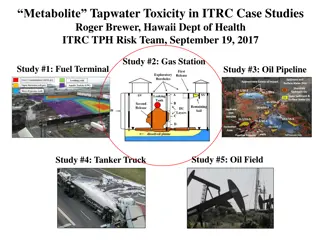Strategic Roadmap for Nigeria's Petroleum Industry: 2019-2023
This document outlines the key strategic priorities set by the Ministry of Petroleum Resources in Nigeria for the period 2019-2023. It covers objectives such as eradicating fuel smuggling, increasing crude oil production, reducing extraction costs, promoting legislative reforms, enhancing refining c
2 views • 32 slides
Understanding Non-Aqueous Solvents: Types and Classification
Inorganic non-aqueous solvents play a crucial role in chemical research and industry. This article by Dr. Princy K.G. delves into the classification of solvents based on protonicity, polarity, and aqueous vs. non-aqueous nature. It explores the types of non-aqueous solvents, such as protonic and non
1 views • 29 slides
Isolation and Analysis of Alkaloids: Atropine, Quinine, Reserpine, Caffeine
Alkaloids are extracted and isolated based on their basic character and solubility patterns using processes like Stas Otto. The general method includes treating plant material with solvents, extracting with ethanol, and separating bases using various techniques. Atropine, obtained from plants like A
2 views • 28 slides
Petroleum Refining Industry in South Africa: Current Overview
South Africa's economy heavily relies on petroleum, with an installed refining capacity of 520,000 barrels per day and additional Coal-to-Liquid and Gas-to-Liquid refineries. Despite challenges like operational disruptions, the sector plays a crucial role in the country's energy security and economi
0 views • 16 slides
Understanding Petroleum Fraction Distillation Curves
Characterization and properties of petroleum fractions are essential for understanding their behavior, particularly through distillation curves. These curves depict the boiling points of crude oil or petroleum fractions, highlighting components' volatility ranges. Various methods like ASTM D86, True
0 views • 28 slides
Bulk Petroleum Products Handling Procedures at Fuel System Supply Point
Learn how to receive and issue bulk petroleum products using the Fuel System Supply Point (FSSP) in the army. This training covers safety precautions, procedures, and best practices for handling petroleum products efficiently and safely in the field.
0 views • 59 slides
Fuel Pricing Transparency and Capacity Building Workshop in Suva, Fiji
Exploration, drilling, refining, and transportation costs in the petroleum industry were discussed at the SPC Petroleum Workshop in Suva, Fiji. The workshop also covered onshore costs, duties, operating costs, and return on capital employed. Participants shared PICTs experiences on fuel facilities,
0 views • 6 slides
Procedures for Granting Petroleum Exploration Licence by Ministry of Mines and Minerals Development
The Ministry of Mines and Minerals Development outlines the procedures for granting a petroleum exploration licence, including the main stages such as constitution of blocks, advertisement, application evaluation, recommendation, licence offer, and licence grant. These stages involve key activities
0 views • 11 slides
Deep Eutectic Solvents: Classification, Synthesis, and Applications
Deep Eutectic Solvents (DES) are versatile solvents formed by mixing specific acids and bases. These solvents exhibit unique hydrogen bonding properties, resulting in a lower melting point compared to individual components. DES can be classified into hydrophobic and hydrophilic types, each with dist
3 views • 7 slides
Overview of U.S. Petroleum and Natural Gas Production Trends
This detailed content discusses the production and consumption of crude oil, natural gas plant liquids, and petroleum liquids in the United States. It covers historical data, projections, economic growth scenarios, and price cases for the period up to 2050. The information sheds light on production
0 views • 18 slides
Proper Petroleum Marking and Inspection Guidelines for Vehicles and Equipment
As a petroleum supervisor, it is essential to inspect vehicles and equipment to ensure proper markings, preventing commingling of products and ensuring safety. This lesson covers the inspection of petroleum markings on tank vehicles, safety markings for bulk transportation, marking requirements for
0 views • 152 slides
Solvents for Chemistry Enthusiasts
Explore the power of solvents with Dr. A. Stella Shalini, Assistant Professor of Chemistry at St. Joseph's College, Trichy-2. Learn about the properties of water as a universal solvent, its ability to dissolve substances like salt, and non-aqueous solvents such as liquid ammonia. Discover the classi
0 views • 8 slides
Management of Symptomatic Ear Wax in Adults: Olive Oil Drops vs. Alternative Solvents
Adults (>18 yrs) presenting with symptomatic ear wax often seek interventions like olive oil drops or alternative ear wax solvents. A study compared the efficacy of olive oil drops in conjunction with syringing versus alternative treatments or no treatment. PubMed search yielded 26 papers, with 2 re
5 views • 12 slides
Petroleum Exploration Activities in Nicaragua: A Comprehensive Overview
Nicaragua has a rich history of petroleum exploration, with activities dating back to 1930. The country has seen significant seismic acquisition and drilling efforts both onshore and offshore in the Caribbean and Pacific regions. Wells drilled in Nicaragua have shown promising oil and gas indication
0 views • 16 slides
Norway's Oil for Development Program: Addressing the Resource Curse
Norway's Oil for Development program aims to manage petroleum resources responsibly to benefit future generations, transforming the resource curse into a blessing. Established in 2005, the program focuses on capacity development, public finance, and environmental concerns in oil economies. It has sh
0 views • 17 slides
Understanding Coating Composition for Tablets: A Guide by Mrs. Kalpana, Assistant Professor
Mrs. Kalpana, an Assistant Professor at U.I.O.P., CSJMU, Kanpur, delves into the components of tablet coating composition including solvents, plasticizers, colorants, and opaquant-extenders. Solvents are crucial for dissolving polymers, while plasticizers modify film quality. Colorants add elegance
1 views • 10 slides
Understanding Solutions and Solubility in Chemistry
Explore the concepts of solutions, solvents, solutes, and solubility in chemistry through investigations with various substances and solvents. Learn how to differentiate between dilute, concentrated, and saturated solutions, measure solubility, create solubility curves, and understand crystallizatio
0 views • 36 slides
Overview of Ghana's Petroleum Downstream Industry
The Ghana Petroleum Downstream Industry plays a vital role in the transportation, processing, distribution, and marketing of refined petroleum products. The industry has seen key policy objectives focusing on deregulation and liberalization to promote competition and efficiency. Historical milestone
3 views • 23 slides
Understanding the Petroleum Driver Passport (PDP) Program
The Petroleum Driver Passport (PDP) program aims to standardize training for petroleum tanker drivers in the UK, ensuring a consistently high level of classroom and practical training. The PDP is a driver card that all drivers must possess, regardless of employer or type of vehicles used. Industry-a
0 views • 36 slides
Overview of Norwegian Petroleum Directorate and Offshore Oil Fields
The Norwegian Petroleum Directorate (NPD) plays a vital role in regulating petroleum resources on the Norwegian continental shelf to ensure optimal allocation with minimal environmental impact. Haltenbanken area in the Norwegian Sea hosts challenging oil and gas fields like sgard, Heidrun, and Krist
0 views • 18 slides
Understanding Petroleum Metabolite Toxicity in Environmental Case Studies
Exploring the impact of metabolites from petroleum degradation on tap water toxicity through case studies involving gas stations, fuel terminals, oil pipelines, oil fields, and tanker trucks. The assessment of TPH risk levels in different settings, calculation of screening levels for drinking water,
0 views • 17 slides
Development of Presumption Criteria for Solvent-Induced Hearing Loss
Development of a presumption criteria by the Department of Labor (DOL) for identifying the exposure-disease relationship in cases of solvent-induced hearing loss. The DOL requires a diagnosis of sensorineural hearing loss in both ears, exposure to specific solvents, and a history of working in desig
0 views • 7 slides
Montana Petroleum Tank Releases and Closures Analysis
The provided content details data on Montana's petroleum tank releases, confirmations, closures, and cleanup efforts from 1987 to 2020. It includes information on confirmed and resolved releases, annual averages, legacy releases, EPA regulations, risk-based corrective action guidance, and screening
0 views • 14 slides
Understanding Petroleum Contact Water (PCW)
Petroleum Contact Water (PCW) refers to water containing petroleum products in various contexts such as condensate, tank bottoms, spill containment areas, and more. This definition excludes certain materials like equipment wash water and groundwater contaminated with hazardous constituents. A PCW tr
0 views • 9 slides
Challenges and Goals of Petroleum Marketers in Environmental Compliance
Facing compliance challenges in maintaining underground storage tanks, petroleum marketers aim to invest in real estate, technology, and environmental protection to secure their investments. Issues such as vapor recovery, EMV upgrades, and regulatory developments impact the petroleum retail sector.
0 views • 10 slides
Somalia's Petroleum and Mining Legal Framework
The legal and commercial framework governing petroleum and mining in Somalia involves the separation of powers between key institutions such as the Ministry of Petroleum and the Somali National Oil Company. The Directorate of Minerals/Mining oversees the mining sector, while various regulations and
0 views • 11 slides
Understanding Chromatography: A Practical Experiment
Chromatography is a process used to separate components of a mixture by employing a mobile phase that carries the mixture through a stationary phase. This experiment by Mariam Nimri explores the effects of different solvents on chromatography results, with a hypothesis that vinegar can impact pigmen
1 views • 10 slides
Nucleophilic Substitution Reactions: Factors Affecting SN2 Reactivity
Understanding the factors influencing SN2 reactions in synthetic gateways involving elimination reactions of alkenes is crucial for predicting reaction rates. This includes analyzing the impact of solvent types on reaction rates in different scenarios. Polar protic solvents and polar aprotic solvent
0 views • 19 slides
Understanding Solvent Effects in Organic Chemistry
Different solvents can have varying effects on chemical reactions by influencing solubility, stability, and reaction rates. Solvents can control the pathway towards forming either thermodynamic or kinetic products based on their selection. Solutes dissolve based on intermolecular interactions with s
0 views • 6 slides
Evaluation of Petroleum Hydrocarbon Degraders in Wastewater Canal Supplemented with Organic Carbon Source
This study explores the potential of native bacterial populations in wastewater for bioremediation of petroleum hydrocarbon-polluted environments. The research involved exposing Bonny light crude oil to wastewater canal samples supplemented with dry maize cob as an organic carbon source. Results sho
0 views • 26 slides
Understanding Solvents in NMR Spectroscopy
Solvents play a crucial role in NMR spectroscopy, with characteristics like chemical inertness and lack of hydrogen atoms being key. Deuterated solvents are commonly used, but even they may show peaks due to impurities. Different deuterated solvents have varying chemical shifts and multiplicities fo
0 views • 15 slides
Petroleum Restoration Program Site Managers Workshop in Orlando, Florida
The division of Waste Management organized the Petroleum Restoration Program (PRP) Site Managers Workshop in Orlando, Florida on March 25-26, 2014. The workshop covered various topics related to PRP, including procurement workflow, scope of work development, remediation strategies, site closure, and
0 views • 48 slides
Criteria for Solvent-Related Hearing Loss and Compensation Claims
The Department of Labor (DOL) has specific criteria for accepting claims related to solvent-induced hearing loss in employees. If an employee has sensorineural hearing loss in both ears, was exposed to certain chemical solvents, and worked in particular job categories for a concurrent 10-year period
0 views • 8 slides
Long-Term Management of Contaminated Soil and Groundwater in Iwilei District, Honolulu
The Iwilei District in Honolulu, Hawaii, spans 315 acres with multiple landowners and responsible parties. It features commercial and industrial use, including bulk fuel terminals, former MGP site, active/inactive petroleum pipelines, and Dole Cannery. The area has been impacted by petroleum-contami
0 views • 25 slides
Essential Techniques in Chemical Research
Learn about key research techniques in chemistry including preparation methods, drying techniques, chromatography, spectroscopic techniques, and specific solvents used. Understand the importance of starting material preparation, drying reagents such as calcium chloride and molecular sieves, and how
0 views • 15 slides
Rules for Treating Petroleum Releases: 15A NCAC 02L Section
The rule-making aims to establish consistent rules for addressing petroleum releases, specifically focusing on risk-based remediation for non-UST petroleum releases. The new rules in the 15A NCAC 02L Section aim to prevent misuse of statutes and federal regulations. A comparison is made between non-
0 views • 19 slides
Understanding Petroleum Hydrocarbons and Their Properties
Petroleum is a complex mixture of hydrocarbons, including paraffins, olefins, naphthenes, and aromatics. Paraffins are fully saturated and stable, olefins are unsaturated with double bonds, naphthenes are cyclic saturated hydrocarbons, and aromatics are cyclic unsaturated hydrocarbons containing ben
0 views • 19 slides
Study of Distillation Characteristics of Kerosene and Petroleum Solvents
This research proposal aims to investigate the distillation characteristics of Kerosene (IS 1459) and Petroleum Hydrocarbon Solvents (IS 1745) to differentiate between them. With overlapping boiling points, it is crucial to determine the 50% and 95% volume recovery temperatures in both standards to
0 views • 11 slides
Regulation of Petroleum Products and Pricing in Atlantic Canada
Island Regulatory & Appeals Commission (IRAC) in Prince Edward Island plays a crucial role in regulating the distribution and pricing of petroleum products within the province. The Petroleum Products Act ensures fair pricing for consumers and licensees, with IRAC overseeing price regulation and lice
0 views • 22 slides
Understanding Sterile Pharmaceutical Products Development
Sterile products are dosage forms free of viable microorganisms, crucial for parenteral administrations to ensure therapeutic efficacy and patient safety. This article covers the importance of sterile products in the pharmaceutical industry, the development objectives, different routes of administra
0 views • 31 slides







































